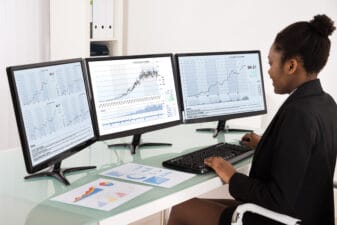Like many things in life, the hardest part about investing can be just getting started. If you have managed to set aside $5k to start your investment journey, congratulations! Here we look at the next steps involved in building your investment portfolio.
Roadblocks
Fear and uncertainty are two of the biggest roadblocks that prevent people from taking positive action to realise their plans. You may have heard about the potential returns to be made from investing in the share market, but have no idea how to access it. Or you may have heard horror stories about those that made poor investing decisions, and fear the potential outcomes of investing your hard earned cash.
The investment universe can be confusing. There are so many investment options to consider (shares, options, ETFs, bonds, the list goes on) and we all want to make optimal choices about how to invest our money. The key is to understand your goals, understand your options and match them appropriately.
Goals and timeframes
The share market can be volatile. Share prices move up and down on a daily basis. Prices of individual stocks react to company specific factors, as well as economy wide factors. Over time, however, stocks tend to outperform lower risk asset classes such as bonds. Over the last 100 years, Australian assets have on average returned 4% more per annum than "risk-free" assets such as government bonds.
Of course, there have been periods when equities have returned far less than than "risk-free" assets. Between October 2007 and March 2009, the ASX200 fell more than 53%. This is one of the reasons why investors in the share market should have a longer-term time horizon in mind. Shares are a long-term investment best suited to those who intend to stay in the market for at least 5 to 7 years. This helps to ameliorate short-term risk and smooth out fluctuations in price and performance. If you are definitely going to need your capital in the next 2 to 3 years, you may be better off choosing a lower risk route such as a term deposit.
Diversification
The price of any particular share can fluctuate (sometimes dramatically) without much notice. If you put all your money into a single share, you will be totally exposed to these prices changes. This is one of the reasons experts recommend diversifying. Diversifying involves building a portfolio of multiple holdings across industries and sectors.
A diversified portfolio will be less exposed to the impact of volatility on the price of individual shares or events that impact share prices across an industry. Diversified portfolios leave you less exposed to the risk of a single economic event, so if a particular business or sector isn't performing well, you won't lose all your money.
Diversification can occur not just across the share market, but across asset classes. As well as Australian shares, you may wish to have exposure to government or corporate bonds, property, or international shares. By not putting all your eggs in one basket you reduce the overall risk of your portfolio as well as the volatility of returns.
Investments
So, where to invest your $5k? To achieve maximum market exposure and sufficient diversification, investing across a range of exchange traded funds (ETFs) is a great way to begin. Exchange traded funds are funds which are traded on the stock exchange like ordinary shares. The funds hold assets such as shares, bonds, commodities, or other investments. Because ETFs hold multiple assets and usually charge low management fees they are a popular choice for diversification.
Australian shares
To begin a $5k portfolio, exposure to Australian stocks is an obvious starting point. The Betashares Australia 200 ETF (ASX: A200) provides exposure to the largest 200 companies listed on the ASX based on market capitalisation. Distributions are paid quarterly and management fees are 0.07% per annum.
The fund returned 12.48% in the year to 30 September. Top holdings include Commonwealth Bank of Australia (ASX: CBA), BHP Group Ltd (ASX: BHP), CSL Limited (ASX: CSL), Westpac Banking Corp (ASX: WBC), National Australia Bank Ltd (ASX: NAB), Australia and New Zealand Banking Group (ASX: ANZ), Woolworths Group Ltd (ASX: WOW), and Wesfarmers Ltd (ASX: WES).
Australian fixed interest
Exposure to fixed interest securities may also be desirable in order to provide for diversification benefits. Corporate and government bonds can also be accessed via ETFs. The iShares Core Composite Bond ETF (ASX: IAF) provides exposure to Australian investment grade fixed income securities.
The fund makes distributions quarterly and management fees are 0.20% per annum. The fund has returned 10.98% in the year ending 30 September and invests in Treasury, Government Related, and Corporate Bonds. As at 30 September, 73.99% of holdings were rated AAA and 18.76% of holdings were rated AA.
International shares
To mix things up a bit, it can be worth adding some international exposure to your portfolio. The VanEck Vectors MSCI World ex Australia Quality ETF (ASX: QUAL) provides exposure to some of the largest listed companies in the world outside of Australia. The fund tracks the MSCI World ex-Australia Quality Index and provides access to 300 international shares in a single trade.
The fund returned 20.63% in the year to the end of October. Distributions are made annually and management costs are 0.40% per annum. Top holdings include Apple, Microsoft, Facebook, Visa, Johnson & Johnson, Alphabet, MasterCard, Procter & Gamble, and Roche Holding AG.
Asset allocation
Deciding how much to invest of your $5k to invest in each of these ETFs will depend on your risk profile and investment goals.
If you are comfortable taking on greater amounts of risk, you may prefer to devote more funds to riskier assets. In this case you will probably look to invest proportionately greater amounts in funds devoted to Australian and international shares.
For those who prefer to take on less risk, or who are nearing retirement, it may be more appropriate to devote proportionately more funds to fixed income securities.
Regardless of your chosen asset allocation, in order to build the size of your portfolio as quickly as possible it is important to reinvest your returns. This can be done through dividend reinvestment programs or by simply saving your distributions for your next investment.
Foolish takeaway
With your $5k invested across these 3 ETFs you will be on your way to establishing a well diversified starter portfolio. You can build on this portfolio by adding additional ETF holdings or specific share holdings as you build your investment experience.








